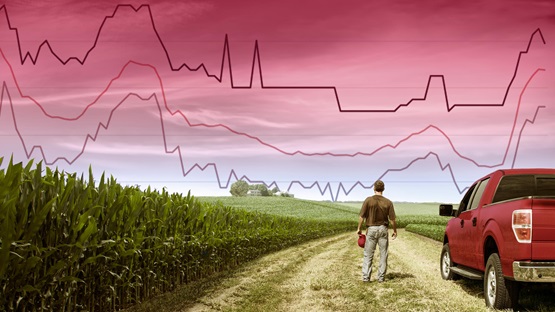The corn market wasn’t awful in 2023 for Tysen Rosenau, a farmer in Carrington, North Dakota, but it wasn’t great either. Prices were lower than the prior year and finding buyers got a bit harder.
“We typically export by truck quite a bit of corn to Canada,” he said. “Every year the Canadians have been raising more corn locally, so they need less of ours.”
Many other farmers around the country also found 2023 challenging. During the year, the value of U.S. agricultural exports plunged by 15 percent, the most significant decrease in decades, according to U.S. Department of Agriculture (USDA) statistics.
The main contributors to that decrease were commodities that dominate farming in the Ninth District, such as corn, soybeans, beef, and wheat. As a result, it’s likely that agricultural exports from the district fell further than exports from the rest of the nation.
Agricultural experts say this decline is in part a return to normal levels after two boom years for exporters. But it also reflects long-standing challenges for farmers, including a strong U.S. dollar and intense competition from countries such as Brazil and Russia.
“China is a big buyer,” said Jiwon Kim, director of global business development at the North Dakota Trade Office. “They usually import a lot from the U.S., but China is importing from South America more than the U.S. because their production is high, crop quality is good, and price is very attractive.”
Big drops
Among America’s ag exports, soybeans and corn are the biggest, accounting for more than a quarter of the total value in 2022. They also account for the same share of cash receipts, meaning farmers’ gross income from sales of ag commodities, according to the USDA. In the Ninth District they accounted for about a third of the value of cash receipts.
Corn and soybean exports together fell by 25 percent in 2023. That’s a decrease of $14 billion, roughly half of the $30 billion decrease for all ag exports (Figure 1). Other exports that decreased significantly include wheat and beef, along with cotton, which is not produced in the district.
Determining how the decrease affects each state is not straightforward. Many ag products are sold to intermediaries who mix products from different states before selling them to foreign and domestic customers. There’s no easy way to determine which corn kernels or soybeans inside of a boat’s cargo hold came from which state. The USDA tries to estimate state exports using each state’s share of total cash receipts for each product (Figure 2). For example, if Minnesota corn growers were paid 9 percent of the total paid to all U.S. corn growers, then Minnesota corn exports would be 9 percent of all U.S. corn exports.
Official estimates aren’t yet available for 2023. If states’ share of cash receipts in 2023 were the same as in 2022, most Ninth District states would have seen exports fall further than the rest of the nation. Montana would have had it worse with a 19 percent decrease, followed closely by North and South Dakota with 18 percent. Michigan would have done the best with a decrease of 14 percent, though most of its farmlands lie outside district borders.
States that likely had it worse would’ve had a greater share of hard-hit ag products in their mix and a smaller share of ag products that sold well. Montana, for example, likely suffered more because wheat accounted for nearly half of the state’s ag exports in 2022. U.S. wheat exports fell by close to a third. Minnesota’s export decline was more moderate because its farming is more diversified. Its biggest export was soybeans, which made up 28 percent of the state’s ag exports. U.S. soybeans fell by 22 percent. Pork, Minnesota’s fourth biggest export, grew slightly.
These estimates don’t account for differences among states that affect their propensity to export, such as high transportation costs to ports or being close to major domestic customers like ethanol or meat-processing plants. But the estimates do give a rough idea of how much each state exports based on the mix of ag products from its farms and ranches.
Return to normal
One important reason ag exports fell in 2023 is that 2022 was an unusually strong year.
According to USDA experts, 2021 and 2022 were huge years for exports, and last year was a return to more normal patterns.
Adjusted for inflation, U.S. ag exports grew by 13 percent between 2020 and 2021 and remained at the elevated level in 2022.
Corn led the way in 2021 thanks to strong demand in China and Canada, ample supplies in the U.S., and meager supplies in Brazil and Ukraine, according to the USDA. 2022 was slightly better because of high commodity prices and tight supplies of some grains due to the war in Ukraine.
That led to huge gains for farmers around the U.S., with inflation-adjusted cash receipts increasing by 15 percent year over year in 2021 and by 14 percent in 2022, according to USDA statistics. Farmers in Ninth District states followed a slightly different path. Their cash receipts grew by 20 percent in 2021 thanks to good harvests, but shrank 12 percent in 2022 because the following harvest was hurt by drought.
Global supplies have since bounced back and prices have fallen. For example, Brazil reached a record of 137 million tons of corn in the 2022–23 season, a nearly 60 percent increase over the 2020–21 season. Global corn prices, which peaked at $349 per metric ton in April 2022, were down 16 percent a year later, according to the International Monetary Fund. As of December 2023, they had fallen to $207.
The USDA hasn’t released 2023 cash receipts yet.
Long-term trends
While 2023 might be a return to normal for U.S. ag exports, farmers face some long-term challenges that will likely hold back future growth. These include a strong U.S. dollar, making U.S. exports more expensive for other nations, and growing competition from Brazil and other places.
For farmers, these challenges translate into slimmer margins, even for those not facing direct competition. Commodities markets are global markets where major players like Brazil have major influence. When Brazil has a good harvest, the increase in supply can result in lower prices across the globe, from China’s Dalian Commodity Exchange to the Chicago Board of Trade.
Rosenau mostly exports to Canada, a market now dominated by U.S. corn growers. But Canadian buyers, like American buyers, reference Chicago prices. That’s why Rosenau is worried about Brazil.
“As they become more competitive in the marketplace, it affects our actual Board price,” he said.
In the past decade, Brazil has emerged as one of America’s biggest rivals in ag exports, especially in the world’s biggest market, China. While the U.S. dollar has gained strength relative to the Chinese yuan, the Brazilian real has weakened. Compared with 2013, the dollar in 2023 was worth 15 percent more yuan while the real was worth 50 percent less yuan. All things being equal, that means China would be able to buy more from Brazil than the U.S. for the same amount of yuan.
But Brazilian farmers have also been able to lower their production costs for some important crops. In 2010, the USDA estimated a bushel of soybeans costs U.S. farmers 9 percent more to produce than it costs Brazilian farmers. By 2021, the gap had widened to 14 percent.
The cost of getting crops from Brazil’s inland states to coastal ports has decreased as the country improved its highways and rails. Between 2014 and 2022, the cost of hauling soybeans from northern Mato Grosso, Brazil’s most productive soybean region, to the Port of Santos fell by 27 percent, according to the USDA. In the same time frame, the cost of hauling crops from Fargo, North Dakota, to Pacific Northwest ports grew by 15 percent.
U.S. ag exports are still growing, but these headwinds mean American farmers are losing market share in the global market. In 2010, the U.S. was the top exporter of soybeans, corn, and wheat. In 2023, Brazil was the top soybean and corn exporter, and Russia was the top wheat exporter.
While there is still geopolitical tension with China, the world’s biggest agricultural importer, most observers consider declining U.S. ag exports to be more about economics.
“China’s gonna buy from whoever they can buy from the cheapest,” said James O’Connor, a farmer and member of the Minnesota Corn Research & Promotion Council. To regain its edge, the U.S. needs to pursue more trade agreements with promising markets for corn-related products, such as India and countries in Southeast Asia, he said.
More of the same in 2024?
2024 doesn’t look like it will be an improvement for ag exporters, according to a recent USDA forecast. Total exports in fiscal year 2024, which began October 1, are expected to total $169.5 billion, a 5 percent decrease from 2023. The forecast isn’t available for the calendar year.
Contributing to that decrease are ag products important to the Ninth District. Wheat and corn exports are expected to fall because prices are lower as the U.S. competes with other exporting countries. Soybean and beef exports may also fall because U.S. production has decreased.
At O’Connor’s farm in Blooming Prairie, Minnesota, the lower corn prices could be a big problem. Drought hurt his harvest in 2023, and what seemed like lower prices then encouraged him to put more corn in storage in hopes of higher prices this year.
Prices have only gotten lower.
“We’re getting really close to a point where we will be selling that crop at a loss,” he said.
Tu-Uyen Tran is the senior writer in the Minneapolis Fed’s Public Affairs department. He specializes in deeply reported, data-driven articles. Before joining the Bank in 2018, Tu-Uyen was an editor and reporter in Fargo, Grand Forks, and Seattle.





